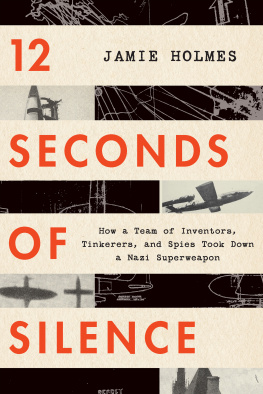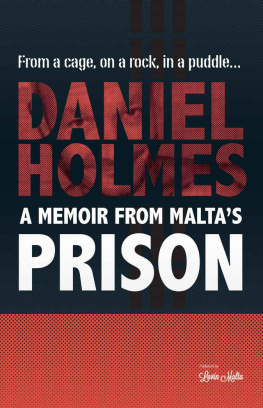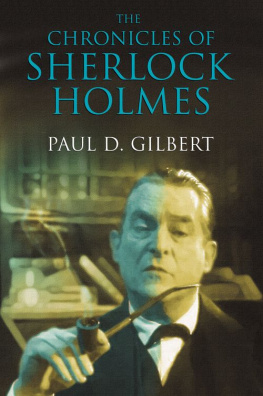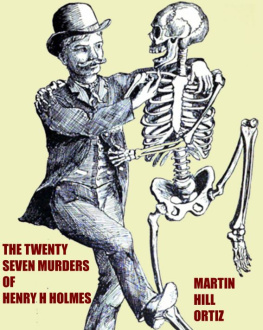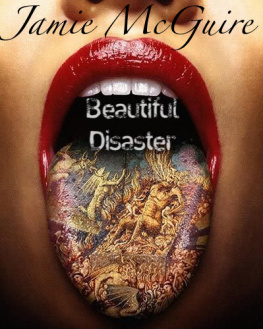Jamie Holmes - 12 Seconds of Silence
Here you can read online Jamie Holmes - 12 Seconds of Silence full text of the book (entire story) in english for free. Download pdf and epub, get meaning, cover and reviews about this ebook. year: 2020, publisher: HMH Books, genre: Non-fiction. Description of the work, (preface) as well as reviews are available. Best literature library LitArk.com created for fans of good reading and offers a wide selection of genres:
Romance novel
Science fiction
Adventure
Detective
Science
History
Home and family
Prose
Art
Politics
Computer
Non-fiction
Religion
Business
Children
Humor
Choose a favorite category and find really read worthwhile books. Enjoy immersion in the world of imagination, feel the emotions of the characters or learn something new for yourself, make an fascinating discovery.
- Book:12 Seconds of Silence
- Author:
- Publisher:HMH Books
- Genre:
- Year:2020
- Rating:5 / 5
- Favourites:Add to favourites
- Your mark:
- 100
- 1
- 2
- 3
- 4
- 5
12 Seconds of Silence: summary, description and annotation
We offer to read an annotation, description, summary or preface (depends on what the author of the book "12 Seconds of Silence" wrote himself). If you haven't found the necessary information about the book — write in the comments, we will try to find it.
12 Seconds of Silence — read online for free the complete book (whole text) full work
Below is the text of the book, divided by pages. System saving the place of the last page read, allows you to conveniently read the book "12 Seconds of Silence" online for free, without having to search again every time where you left off. Put a bookmark, and you can go to the page where you finished reading at any time.
Font size:
Interval:
Bookmark:
Copyright 2020 by Jamie Holmes
All rights reserved
For information about permission to reproduce selections from this book, write to or to Permissions, Houghton Mifflin Harcourt Publishing Company, 3 Park Avenue, 19th Floor, New York, New York 10016.
hmhbooks.com
Library of Congress Cataloging-in-Publication Data
Names: Holmes, Jamie, author.
Title: 12 seconds of silence : how a team of inventors, tinkerers, and spies took down a Nazi superweapon / Jamie Holmes.
Other titles: How a team of inventors, tinkerers, and spies took down a Nazi superweapon
Description: Boston : Houghton Mifflin Harcourt, 2020. | Includes bibliographical references and index.
Identifiers: LCCN 2019045690 (print) | LCCN 2019045691 (ebook) | ISBN 9781328460127 (hardcover) | ISBN 9780358309512 | ISBN 9780358313144 | ISBN 9781328459855 (ebook)
Subjects: LCSH: Proximity fuzesDesign and construction. | World War, 19391945. | Military weaponsHistory. | Weapons industryUnited StatesHistory20th Century. | United States. Office of Scientific Research and DevelopmentHistory. | Johns Hopkins University. Applied Physics LaboratoryHistory.
Classification:LCC UF780 .H65 2020 (print) | LCC UF780 (ebook) | DDC623.4/542dc23
LC record available at https://lccn.loc.gov/2019045690
LC ebook record available at at https://lccn.loc.gov/2019045691
Cover design by Brian Moore
Cover images: UIG via Getty Images (V-2 bomb); Shutterstock (paper)
Author photograph Marissa Rauch Photography
v1.0720
The beginning of every war is like opening the door into a dark room. One never knows what is hidden in the darkness.
ADOLF HITLER , 1941
On May 7, 1944, in the deep of night, a train carrying the 130th Chemical Processing Company of the U.S. Chemical Warfare Service steamed toward London. The old locomotive had no speedometer, and the blackout hiding southern England from Nazi bombers made it hard for the engine driver to gauge their velocity using landmarks along the tracks. No lights were allowed to shine or leak from the train. Windows had been screened. Snaking through the dark, they passed stations lit only by shaded gas lamps and quiet blue lights.
Before sunrise, capping a three-week trek, the Americans disembarked in the British capital onto trucks with shuttered headlights. Winds from the east blew cool and damp. Nothing had prepared the soldiers, many of them still teenagers, for wartime London. Not the chemical weapons training at hot and dusty Camp Sibert, Alabama. Not the crossing on the SS Exceller accompanied by six destroyers, an aircraft carrier, twelve cargo ships, and nineteen tankers. Not the radio reports.
This London felt otherworldly. Flashlights were dimmed by brown paper, and the bicycle lights permitted were so feeble that many riders pedaled without them. News vendors shouting the latest were marked by their cigarette cherries, fireflies in the gloom. On moonless nights it was a real chore reading a public telephone dial. Naturally, road accidents had spiked. Pedestrians were run over unseen. Commuters even stepped out of trains on the wrong side, while others fell down holes or off bridges. Posters recommended carrots for keener vision.
Adapting to the chaos, Londoners had slathered white paint onto curbs, lampposts, car bumpers, and traffic islands. Grand public steps looked like chessboards. Citizens donned white patches, sleeves, and hat brims. Even pets were protectively attired in white. Traffic signals had been shrunk to slivers of red, green, and amber. Policemen in ghostly tunics wielded faint green flashlights.
To the men of the 130th, Londons dilemma was too surreal to absorb at once. As their trucks navigated the dark streets, they were awed by the damage: a proud capital in tatters, ruins on nearly every block, bomb craters, stripped faades, charred skeletons of buildings, broken timber beams protruding like compound fractures. They could imagine what it all meant: high explosives, parachute mines, incendiary bombs, firefighters battling raging flames, and rescue squads digging all night for the missing. Those heaps of brick signified great trauma and loss.
When the Blitz came, four years prior, the city had scarcely any protection from the German air force. He comes when he wants, one Londoner said, of the Luftwaffe. Theres no stopping him. Panic spread like an airborne virus, prompting the British air command to alter its overwhelming reliance on Royal Air Force fighters and to install dozens of antiaircraft gun sites in and around the city. The booming guns helped reassure residents they were not defenseless.
But aside from the psychological boost to morale, the antiaircraft cannons were largely worthless. In the early weeks of the Blitz, the ratio of fired shells to downed aircrafta metric described in RPB, or rounds per birdwas twenty thousand to one. Taking out a single German aircraft took twenty thousand shots.
The enemy could be hit, but mostly when they flew low and straight during the day. At night targeting was nearly impossible. Planes had to be held in searchlights for primitive aiming devices. American antiaircraft defenses were just as shoddya potential disaster for the U.S. Navy. At the start of the war, an American scientist said, It would be just a sheer stroke of luck to hit anything.
Figuring out how to shoot down airplanessolving the rounds-per-bird puzzlewas one of the toughest, most urgent scientific tasks of World War II.
By the time the 130th Chemical Processing Company reached England in May of 1944, Londoners were tiredof fear, of rationing, of the blackout. A German Baby Blitz claiming more than fifteen hundred British lives was still winding down. And Allied military planners believed things were about to get a lot worse.
The one hundred and forty-eight American chemical warfare specialists were billeted in brick houses at 4, 6, and 8 Sloane Court East in Chelsea, a residential neighborhood on the river Thames. The apartments were situated between a burial ground and a hospital. Just yards away stood two buildings highlighted on the targeting maps of Luftwaffe bombardiers: the British Army barracks and the Duke of Yorks Headquarters.
Among the 130th was Samuel Edward Hatch, eighteen, from Massachusetts, with a wide face, large quiet eyes, and dark brown hair. They called him Ed. He was assigned a second-floor room at 6 Sloane Court East with another teenage Bay Stater, Teddy Booras, a skinny boy with an overbite. The sun rose and the pair set about bringing their improvised quarters up to military standards.
On Monday, May 8, hours after arriving in darkness, Hatch scrawled a careful, bland, reassuring note to his parents back home in Springfield, a midsize city in western Massachusetts. We have been informed by our officers that it is alright to tell you that I am in London and am living in very spacious and beautiful apartments. The food here is the best Ive had in the Army.
D-Day was a month away.
Thousands of soldiers, sailors, planes, combat ships, and beaching craft were being readied for the Normandy landing. An invasion of France would pose a direct threat to the heart of Germany, and the Allies fully expected Hitler to retaliate furiously, unleashing an airborne arsenal of secret weapons they knew were in development. If Nazi scientists could use the mysterious weapons on civilians, Britains capital remained their most plausible target. One Allied intelligence agent even guessed a date for Hitlers counterattack on London: D+7.
American military analysts were especially concerned that Germany was planning to arm their retaliatory warheads with chemical weapons. In World War I, around ninety-one thousand troops died from chemical warfare, mostly from phosgene, a colorless gas four times denser than air that smells like freshly cut grass. By 1938, German science had invented something far more lethal: sarin gas. And the Nazis had already initiated plans to mass-produce the deadly poison.
Font size:
Interval:
Bookmark:
Similar books «12 Seconds of Silence»
Look at similar books to 12 Seconds of Silence. We have selected literature similar in name and meaning in the hope of providing readers with more options to find new, interesting, not yet read works.
Discussion, reviews of the book 12 Seconds of Silence and just readers' own opinions. Leave your comments, write what you think about the work, its meaning or the main characters. Specify what exactly you liked and what you didn't like, and why you think so.

